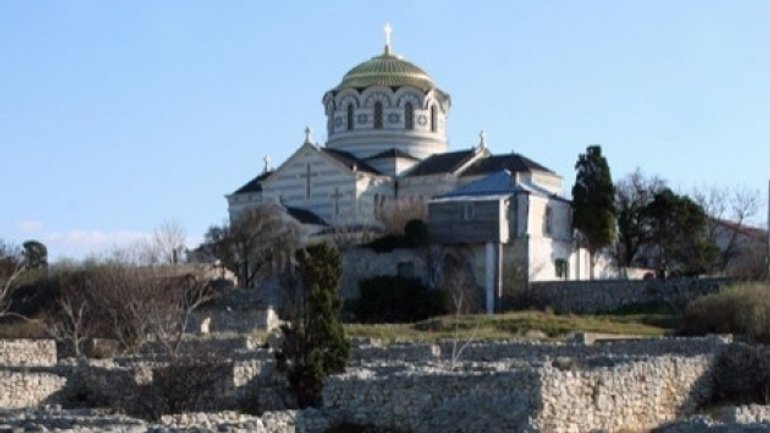Russia is barbarically vandalizing UNESCO world heritage site at Chersonese in occupied Crimea

Russia has dangerous construction plans for a site in occupied Crimea on the UNESCO World Heritage List, with one of the reasons linked with Moscow’s attempts to rewrite its own history. Ukrinform teports.

According to an article published on the website of the Kharkiv Human Rights Protection Group, the barbaric destruction that Russia has caused to the Khan’s Palace in Bakhchysarai make it vital that UNESCO intervenes now over Chersonese before it is too late.
As UNESCO explains, the site in Crimea holds the remains of the ancient city of Tauric Chersonese which was founded by Dorian Greens in the 5th century BC. As well as urban remains, there is also agricultural land, divided into several hundreds of chora, or rectangular plots of equal size which were used for vineyards. Production from the latter was exported by the city which thrived until the 15th century.
Chersonese was added to the World Heritage List in 2013, with mention then of the threats posed to the site by its close proximity to the expanding boundaries of Sevastopol and major issues with conservation.
Recent developments at Chersonese are already putting the site in serious danger, and the plans that the Russian occupiers are proposing only intensify the danger.
During the latest illegal visit by Russian President Vladimir Putin on 11 August, Russian state television showed him attending an elaborate event with lights and special effects staged at the site of the ruins. TV1 reported that Putin had been told of “plans for the development of the reserve”, with these including a museum of Christianity, and archaeological center and a museum of antiquity and Byzantine.
The ideas were put forward by Metropolitan Tikhon (Shevkunov) of Pskov and Porkhov, who is often described as the former KGB agent’s confessor, and who clearly shares Putin’s ‘Russian world’ ideas. The performance was probably based on a version of the history of Crimea and Chersonese written by Tikhon, whose writing plans also include a book about Joseph Stalin.
Whether or not there was an original plan for a museum of Christianity in 1914, it is very clear why such a museum fits the narrative which Moscow has pushed about Crimea and its attempts to treat the peninsula’s history as its own. Any link with Russia begins with the peninsula’s seizure as part of the Russian Empire in 1783. It is a matter of dispute whether Vladimir [or Volodymyr] the Great was himself baptized in Chersonese or in Kyiv, however, the Russian Orthodox Church had certainly earlier never questioned that the mass baptism that marked the Christianization of Kyivan Rus in 988 took place in Kyiv. This is a problem for adherents of ‘Russian world’ mythology, and it seems likely that the museum would be aimed at pushing a different, more ‘Russian’, version of events, one that would gel with Putin’s claim that Crimea has ‘sacred’ significance for Russia.
Anatoly Tumanov, who earlier worked at the Tauric Chersonese museum complex, has told Krym.Realii that under Russian control the museum is not run by scholars, but by “some kind of people with the words ‘Russian Foundation – my history’ on their backs”. He says that they do whatever they please and clearly have no idea where they are, as seen by how they prop metallic fencing against ancient walls.
Tumanov reacted also with horror to another idea floated by the Russian Orthodox Church that it has an active monastery on the territory of Chersonese. This, he says, could seriously damage this monument of world heritage.
Albina Gaevskaya is another Sevastopol scholar, who shares Tumanov’s concerns.
In a Facebook post entitled ‘Save Chersonese!’ on 12 August, she posted a copy of her letter to Vladimir Medinsky, Russia’s minister of culture.
In it she points out that UNESCO has not been carrying out monitoring visits to Chersonese since 2014, as it does not recognize Russia’s ‘jurisdiction’ It is probably because of this, she says, that the current management of the museum are carrying out disastrous ‘reconstruction’ of the ruins of the ancient city without any obstruction and with impunity.
She warns that, as a result, the ancient city could simply disappear. She mentions wooden boards being used to cover the stone roads of the city, with no consideration of the state that these boards will get in. She is even more damning of the methods used to popularize the place, with little booths built where people can supposedly learn about its history and “incredibly ugly banners that look like gallows”. They appear to be trying to turn the place into something like a summer opera theatre or state, with tens or hundreds of meters of cables being stretched out over the territory of the monument for lighting, etc. All of this is enabling them to make profit from events there, but the massive constructions are seriously threatening the integrity of these ruins. Gaevskaya warns that UNESCO may well strip the site of its world heritage status if it sees what is being done to the ancient ruins, how structures that have nothing to do with Chersonese are being erected, and how they’re rolling machines weighing many tons over areas that have not yet been excavated.
While UNESCO is, hopefully, following developments, it has not yet visited Crimea, with the reason in its case, as with other international bodies and NGOs, is probably deliberate policy by Russia. Crimea remains Ukrainian territory, and, while Kyiv is not prohibiting any visits to the peninsula, it does demand that delegations cross into Crimea from mainland Ukraine. Russia, on the other hand, is demanding that any delegates go from Russia and in accordance with Russian legislation. This probably explains why, despite the reports from Ukraine’s Foreign Ministry that UNESCO would be sending a direct monitoring delegation in April 2019, this has so far not happened.
Any major construction work at the site of Tauric Chersones, is prohibited, and all conservation measures should be clearly detailed, and agreed with UNESCO.
Russia has already caused immeasurable damage to other sites of historic and national significance in occupied Crimea, with the worst and most barbaric damage inflicted on the 16th Century Khan’s Palace in Bakhchysarai, a site of immense significance for Crimean Tatars in particular, and for Ukraine.









